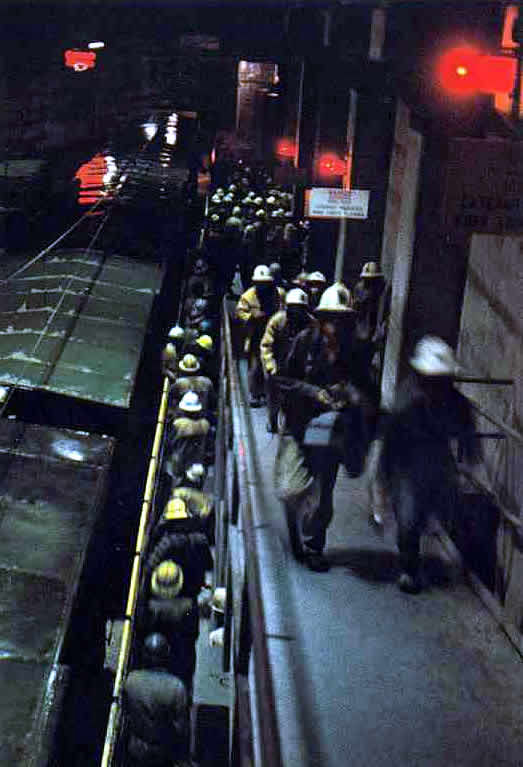Granduc Mine

ENGINEERING AND PLANNING - Continued
Photo - Underground Ramp to Train
THE RAMP SYSTEM
The ramp system while somewhat fatiguing to those, on foot -clearly demonstrated the advantages of moving personnel, equipment, and such things as miniature service stations, on wheeled vehicles. In addition, the ramps allow what could only be called agility and speed on the part of the loaders carrying ore and waste from the draw points to the ore passes.
Shift boss Tino Isola in underground mine office.Grade of the ramps was set at 15%, mainly due to the amount of up-dip driving and the necessity of allowing new operators to familiarize themselves with the large mobile equipment under easier operating conditions. However, it is noted also in a resume of the entire project prepared by George Stenning, general superintendent, that experience and observation of other operations will allow a 20% ramp grade when driven down-dip.
The ramp system was started on the 3100-ft. level and inclined to the 3720- ft. level in a single heading. Then the ramp, in its circular-staircase style, was declined from the original starting point on the 3100-ft. level to the 2600-ft. haul- age level. Since completion of this work in February 1971, the 3100 ramp has been extended into the No.2 mining block where the No.3 ramp will be used to develop the "F" orebody.
The Granduc mine now had 15 Scoop- trams which, while differently designated as to model number, use 5-yd. buckets for ore and waste removal. The ventilation system which was discussed in a different section of this story, was designed to meet the requirements of the B. C. Department of Mines for diesel equipment. Sub-levels branching from the ramp were driven at a grade of 3% and drain adequately through the ventilation raises to the drainage tunnel at the 2475 level.
In the underground mine of this size it was essential to have all service facilities close to the working faces for the sake of speed, efficiency, and economy. This is noted in my comment on the various shops, etc. Another example of this is the mobile assay office which, in a separate section, contains an x-ray quantometer which rapidly performs an analysis of the copper content of an ore sample. This, according to "Marv" Walker, underground superintendent, has proven invaluable in supervision and planning of mine development in that it provides assay results of broken rock in any heading in a matter of a half hour.
As mentioned above, the Scooptrams carry the ore from the drawpoints to ore passes 7 ft. in diameter, which are driven by raise-borers. This work was under contract to Patrick Harrison & Company Limited. The raises were driven at a 70% angle and are rock bolted with roc-loc bolts. They direct the broken material to the gathering-haulage level at the 2600-ft. elevation where 15-ton bottom-dump cars, hauled by Goodman locomotives, were taken to the under- ground primary-crushing plant.
Other work being done underground was by Haste Mine Development of Vancouver, responsible for diamond drilling and the development of Mining Block 2.
ENGINEERING-CONTINUED